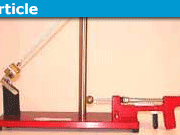Subtleties Overlooked in Friction Questions: Object Slides Down Ramp
Table of Contents
Problem statement (simplified)
An object slides down a ramp at angle θ to encounter level ground. Both surfaces have kinetic friction: μ’ on the ramp, μ on the level. The object reaches the ground at speed u. What is its speed when first fully on the level?
(Original is at https://www.physicsforums.com/threads/distance-a-block-slides-along-a-surface-with-friction-given-with-an-initial-velocity.1047556/.)
There are several missing details, which suggests the author overlooked certain subtleties that can arise in friction problems.
For concreteness, I will take the object to be a uniform rectangular block base length B, height A, diagonal 2r, and A/B=tan(α).
I will assume it is intended that both ends of the base of the block should remain in contact with the surfaces at all times.
Suppose the transition from the ramp to the level ground is via an arc of radius R. The diagram supplied implies R is vanishingly small, but I will start with a simpler case. In any event, I will assume u2>>g max(R,r), which makes gravity irrelevant.
There are two main cases to consider:
r<<R
r>>R
Case 1: r<<R

The maximum rotational KE will be small c.w. the translational KE and will be ignored.
While traversing the arc at speed v=v(θ), the normal force is the centripetal force, mv2/R and the frictional force is μmv2/R, So μv2=-v(dv/dθ), v= ue-μθ . The fraction of KE lost to friction is 1-e-2μθ.
In the original problem, θ=π/6, μ=0.3 for the horizontal surface, 0.2 for the ramp. Using the average, 0.25, the fraction lost is 1-e-π/12, about 23%
Case 2: r>>R
We can treat this case as an impact, i.e. R=0.

To simplify the algebra, all forces and impulses will be taken to be per unit mass.
A solution posted in the thread treats it merely as an inelastic impact in the vertical. Consequently, it finds v = u cos(θ), a loss of 25% of the KE. This overlooks frictional impulse.
There are three stages in the transition to horizontal motion:
The leading edge strikes the ground and starts to move horizontally.
The block continues to slide, the leading edge on the ground, and the trailing edge on the ramp.
The trailing edge strikes the ground.
There are frictional losses during each stage.
Stage 1
When the object strikes the ground, there will be a vertical impulse J from the ground at the leading edge and an impulse J’ from the ramp, normal to the ramp, at the trailing edge of the object.
Correspondingly, a frictional impulse μJ horizontally at the leading edge and a frictional impulse μ’J’ from the ramp, up the ramp, at the trailing edge.
Let the horizontal velocity of the leading edge immediately after impact be v and the rotation rate of the object just after impact be ω. This implies the horizontal velocity of the centre of the object just after impact is v-ωr sin(θ+α), and its vertical velocity is ωr cos(θ+α) (down).
Horizontal momentum conservation:
μJ+ μ’J’ cos(θ) – J’ sin(θ) = u cos(θ) -v + ωr sin(θ+α)
Vertical momentum conservation:
J+J’ cos(θ) + μ’J’ sin(θ) = u sin(θ) – ωr cos(θ+α)
Since the trailing edge continues parallel to the ramp,
v sin(θ) = ωB = 2ωr cos(α)
The moment of inertia of the block is mr2/3.
Angular momentum conservation about block centre:
ωr2/3 = Jr cos(θ+α) – μJr sin(θ+α) – J’r cos(α) – μ’J’r sin(α)
cancelling r:
ωr/3 = J cos(θ+α) – μJ sin(θ+α) – J’ cos(α) – μ’J’ sin(α)
We now have four equations and four unknowns: J, J’, ω, v.
What to choose for α? The original diagram shows a square block, implying α= π/4, it specifies θ =π/6, and sets μ=0.3 for the horizontal surface. However, it turns out that with those angles the back end of the block would lose contact with the ramp when the leading edge hits the ground even with no friction.
We could compromise by using α= 0.49, about 28°, which just avoids loss of contact. This gives a loss of 37% of the KE, and this is just the first stage. (Even α= 0 gives a loss > 25%.)
Instead, I shall simplify matters by setting α= 0. That cuts the stage 1 loss to just over 25%.
Stage 2
Despite choosing α= 0, the equations for this dynamic case are challenging.
At first, it may seem similar to Case 1, but note the trajectory of the mass centre. Taking the centre of the rod object (as now assumed) to be at (x,y) relative to the bottom of the ramp, (x+2y cot(θ))2+y2=r2, an ellipse. I.e. it arcs downwards, requiring a downward centripetal force.
This implies loss of contact at sufficient initial velocity.
Stage 3
Suppose, just before the trailing edge hits the ground, the leading edge is travelling at speed v’ horizontally. The trailing edge must have been travelling at v’ horizontally also, and v’ tan(θ) vertically down. The mass centre of the block was therefore descending at speed v’ tan(θ)/2. On hitting the ground full length, there is a vertically upward impulse mv’ tan(θ)/2. and a frictional impulse μmv’ tan(θ)/2.
In addition, just before impact there was rotational KEr of (1/2)(mr2/3)ω2 where 2rω=v’ tan(θ). Hence KEr=m(v’tan(θ))2/24.
KE just before impact = mv’2/2+mv’2tan2(θ)/8+mv’2tan2(θ)/24.
KE just after impact = mv’2(1-μ tan(θ)/2)2/2
Fraction of initial KE remaining = (1- μ tan(θ)/2)2/(1+tan2(θ)/3)
With θ=π/6 and μ=0.3 that’s about 0.75, or a 25% loss.
Other shapes
How could the problem description be adjusted to make the analysis simpler?
One way would be to specify the shape of the object such that it does not rotate. It could be a triangle ABC, where AB contacts the ramp and BC, the lower edge, is horizontal. So ∠ABC = π-θ.
With tan(∠ ACB)=tan(θ)/2, the mass centre would be vertically above B. This would tip neither while accelerating down the ramp nor when decelerating on the horizontal.
At impact with the ground, there is a vertically upward impulse mv sin(θ) and a corresponding horizontal frictional impulse μmv sin(θ). The resulting horizontal speed is therefore v(cos(θ) – μ sin(θ)). With θ=π/6 and μ=0.3 that’s about 0.716v, a 49% loss of KE.
Masters in Mathematics. Interests: climate change & renewable energy; travel; cycling, bushwalking; mathematical puzzles and paradoxes, Azed crosswords, bridge














Leave a Reply
Want to join the discussion?Feel free to contribute!